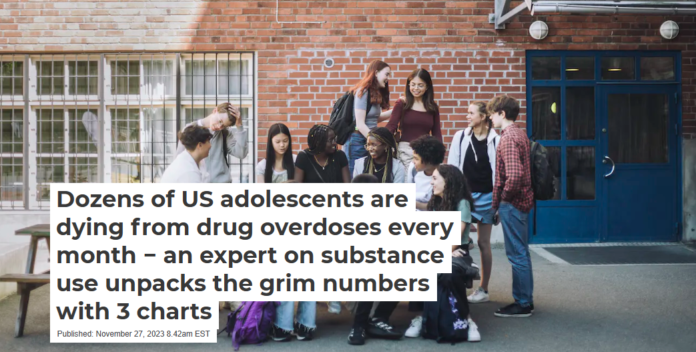

Ty Schepis, Texas State University
Drug overdose deaths in the United States continue to rise.
Overdoses claimed more than 112,000 American lives from May 2022 to May 2023, according to the Centers for Disease Control and Prevention, a 37% increase compared with the 12-month period ending in May 2020.
The vast majority of those who died were adults. But drug overdoses are killing young Americans in unprecedented numbers: The monthly total rose from 31 in July 2019 to 87 in May 2021, the period with the most recent data.
As a scholar of substance use who focuses on patterns that vary between age groups, I’m struck by how adolescents’ overdose deaths differ from adults’ in terms of gender, race and ethnicity and the drugs causing these fatalities.
These differences mean that the groups considered to be at high risk and the strategies needed to prevent overdoses in adolescents should not be the same as for adults.
Who is dying?
When the CDC examined data for Americans 10 to 19 years old, it found that, as is the case for adults, most adolescents dying from drug overdoes are male. However, the share of girls among these fatalities is larger than the share of women.
More than twice as many boys who are tweens or teens are dying of a drug overdose for every girl in that age group.
Among adults, three men die of a drug overdose for every two women.
The share of fatal overdoses of white, non-Hispanic adolescents is vastly greater than for their nonwhite peers – more so than for adults.
Fentanyl’s often to blame
Another difference is what’s causing these fatal overdoses.
Among adults, those who use more than one drug are more likely to die from an overdose than those who use a single drug. The most common combinations are fentanyl with another opioid, like a prescription medication, and fentanyl with a stimulant, like cocaine or methamphetamine.
Fentanyl on its own is the key culprit in adolescent overdoses. For teens, 84% of fatal overdoses involved fentanyl, and 56% of all overdoses involved only fentanyl.
This is consistent with my team’s research indicating that rates of prescription opioid misuse fell from 2015 to 2019 in both adolescents and young adults. It also squares with other data that shows deaths from heroin-involved overdoses have declined in recent years.
Fentanyl is among the most potent opioids available. It’s estimated to be roughly 100 times more potent than morphine – a very strong opioid typically used in hospital settings. Teens and tweens usually have little tolerance to opioids because they often have not been exposed to them before, and fentanyl’s high potency makes them more likely to overdose.
Many adolescents accidentally take fentanyl when they ingest counterfeit pills that they believe are prescription opioids or stimulants, or other illicit drugs that are laced with the drug.
This unintentional use can make an overdose even more likely, because people who are unaware they are taking fentanyl are less likely to have the overdose-reversal medication naloxone or fentanyl test strips on hand.
In 67% of adolescent overdose deaths, a bystander was present who could have intervened. Naloxone was administered in less than half of cases where a bystander was present.
Little to no prior drug history
Only 1 in 10 teens and tweens who died from a drug overdose had a history of treatment for a substance use problem, and only 1 in 7 had ever experienced a prior nonfatal overdose. Adolescents who fatally overdose do not necessarily show the warning signs generally expected beforehand, such as problems with alcohol or other drugs or prior substance use treatment.
This pattern underscores the importance that all parents proactively talk with their children about substance use by the time they are 12 years old.
Parents who express their disapproval of substance use tend to prevent or delay it in their kids. Having children who never use substances may be an unnecessary and unrealistic goal – after all, most adults drink alcohol at least occasionally.
However, parents can emphasize that their child’s brain is changing rapidly and significantly and that not using drugs or alcohol while young helps promote healthy development.
What parents can do
Having naloxone available can also be important. It prevents fentanyl and other opioids from causing an overdose by blocking access to opioid receptors in the brain. This potentially lifesaving drug is easy to use, but the cost of the over-the-counter version, which can exceed $50 for two doses, makes it out of reach for some of the people who need it most.
Think of naloxone like car insurance: You don’t want to use it, but it’s important to have in case something goes wrong.
Even if your child never tries an illicit drug, they may be able to intervene and save a friend who overdoses. Everyone should know the signs of an opioid overdose – they include shallow or no breathing, problems staying conscious, and cold, clammy skin – and be ready to intervene when they see someone of any age who appears to be experiencing one.
Finally, more than 4 in 10 adolescents who died from an overdose had a history of mental health conditions. That’s consistent with research from my colleagues and me linking poorer mental health and opioid misuse in adolescents.
There’s also a strong link between mental health conditions and drug overdoses among adults.
For this reason and many others, such as the rising rates of adolescent depression, I recommend that all adults – whether caregivers or other people in an adolescent’s life – check in on their mental health regularly and recommend or seek treatment for any concerns as early as possible.
Ty Schepis, Professor of Psychology, Texas State University
This article is republished from The Conversation under a Creative Commons license. Read the original article.



















